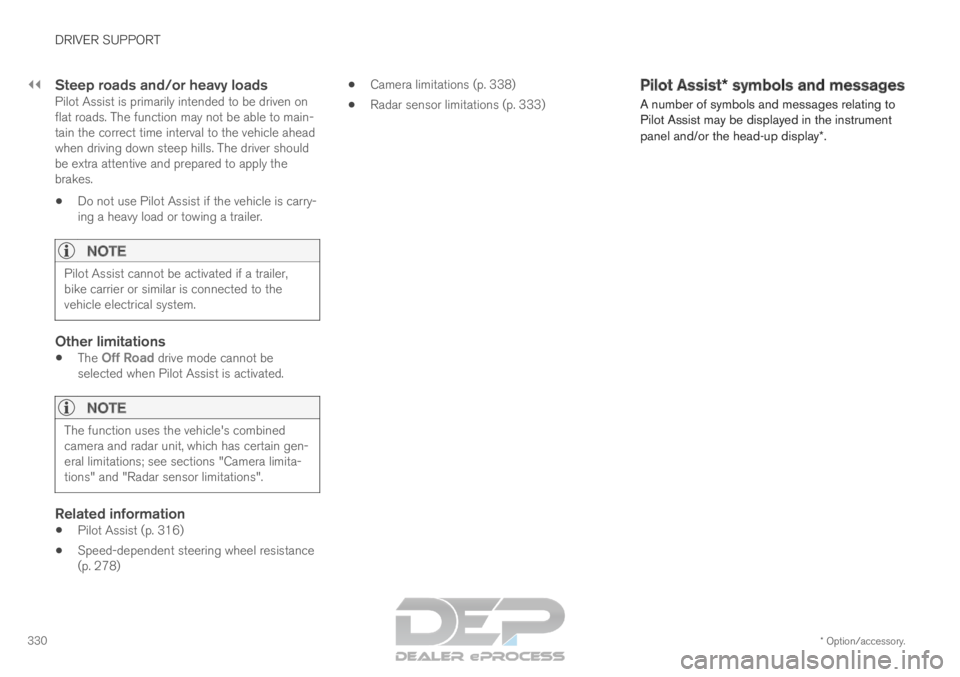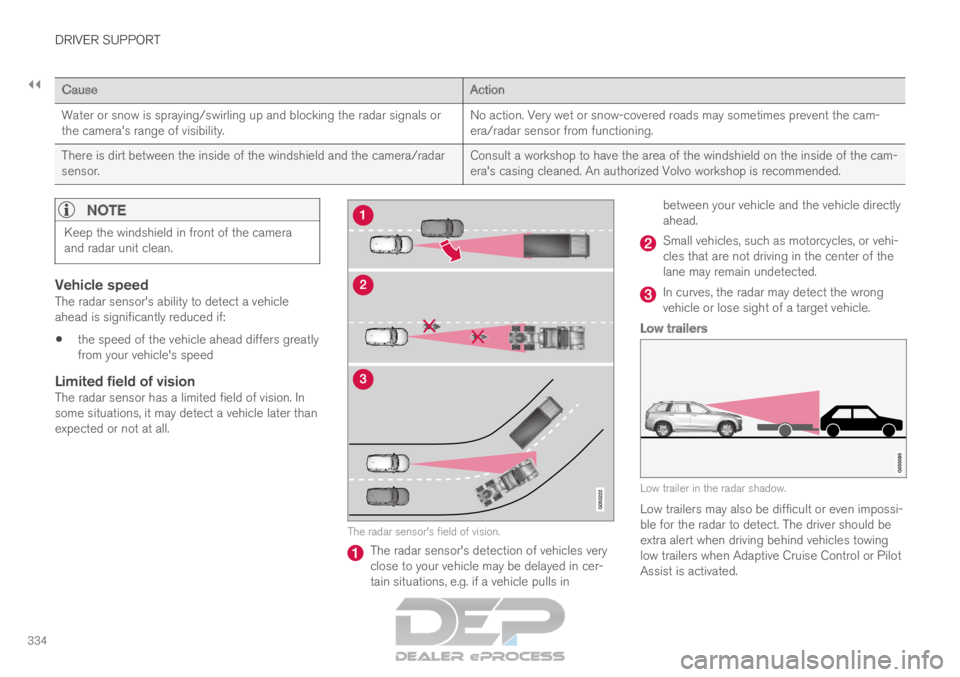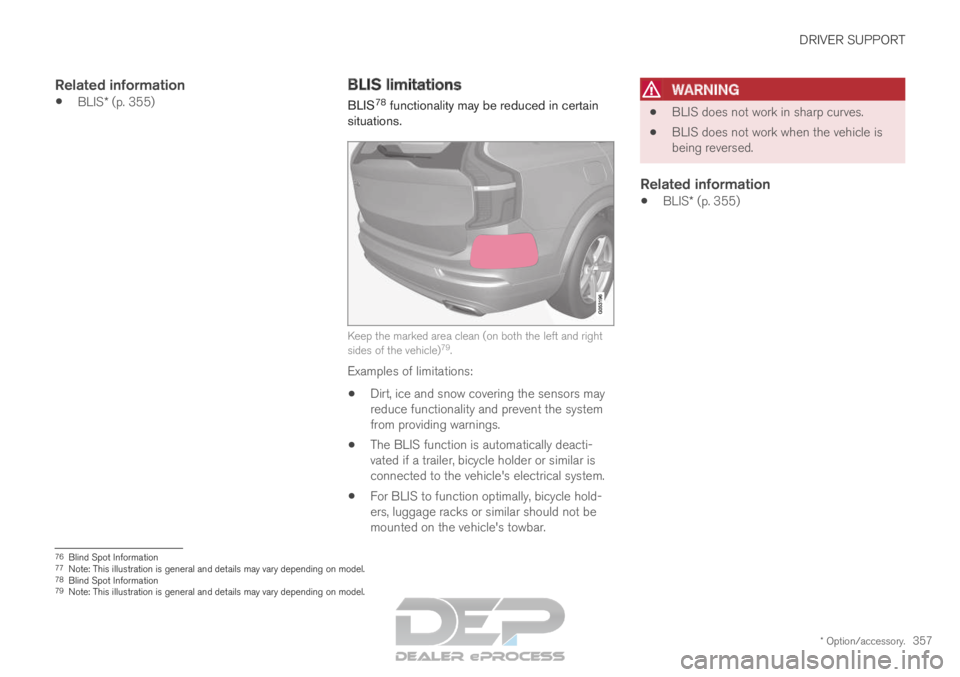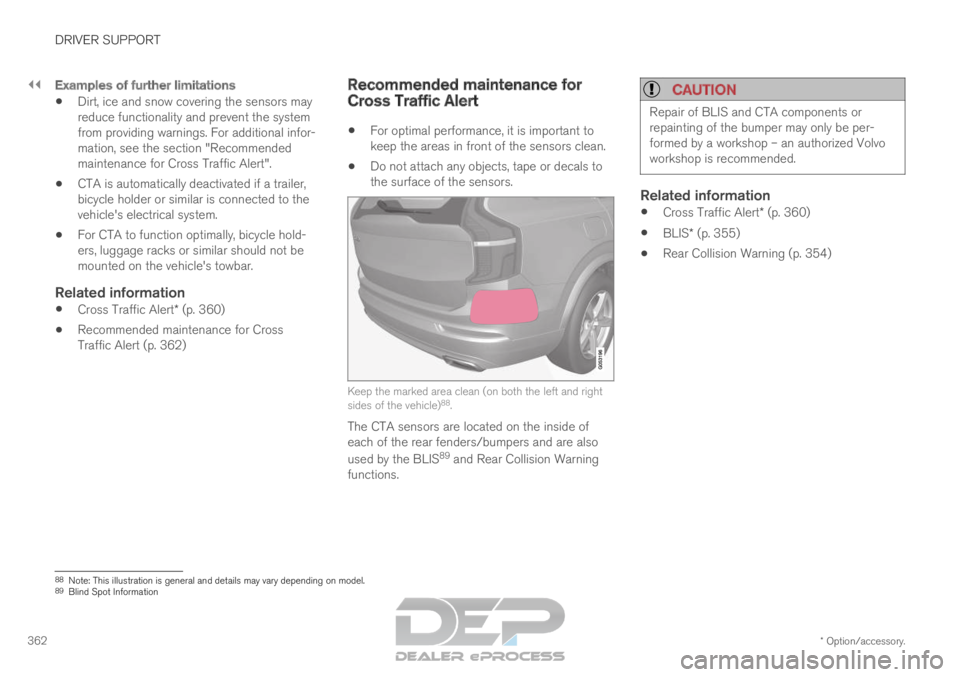tow VOLVO XC90 TWIN ENGINE 2019 Owner's Manual
[x] Cancel search | Manufacturer: VOLVO, Model Year: 2019, Model line: XC90 TWIN ENGINE, Model: VOLVO XC90 TWIN ENGINE 2019Pages: 697, PDF Size: 10.33 MB
Page 328 of 697

||DRIVER SUPPORT
326
WARNING
A noticeable increase in speed may follow
when the speed is resumed with the
steering wheel button.
Related information
Pilot Assist (p. 316) Passing assistance with Pilot Assist
Pilot Assist can assist the driver when passing
other vehicles.
How passing assistance worksWhen Pilot Assist is following another vehicle
and you indicate that you intend to pass that
vehicle by using the turn signal 62
, Pilot Assist will
begin accelerating toward the vehicle ahead
before your vehicle has moved into the passing
lane.
The function will then delay a speed reduction to
avoid early braking as your vehicle approaches a
slower-moving vehicle.
The function remains active until your vehicle has
passed the other vehicle.
WARNING Please note that this function can be acti-
vated in more situations than just passing
another vehicle, such as when a direction indi-
cator is used to indicate a lane change or
before exiting to another road – the vehicle
will then briefly accelerate.
Related information
Pilot Assist (p. 316)
Starting passing assistance with Pilot Assist
(p. 327)
Passing assistance with Pilot Assist limita-
tions (p. 327) 62
Only the left-hand turn signal for left-hand drive vehicles, or right-ha\
nd turn signal for right-hand drive vehicles.
Page 332 of 697

||DRIVER SUPPORT
* Option/accessory.
330
Steep roads and/or heavy loadsPilot Assist is primarily intended to be driven on
flat roads. The function may not be able to main-
tain the correct time interval to the vehicle ahead
when driving down steep hills. The driver should
be extra attentive and prepared to apply the
brakes.
Do not use Pilot Assist if the vehicle is carry-
ing a heavy load or towing a trailer.
NOTE Pilot Assist cannot be activated if a trailer,
bike carrier or similar is connected to the
vehicle electrical system.
Other limitations
The
Off Road drive mode cannot be
selected when Pilot Assist is activated.
NOTE The function uses the vehicle's combined
camera and radar unit, which has certain gen-
eral limitations; see sections "Camera limita-
tions" and "Radar sensor limitations".
Related information
Pilot Assist (p. 316)
Speed-dependent steering wheel resistance
(p. 278)
Camera limitations (p. 338)
Radar sensor limitations (p. 333) Pilot Assist* symbols and messages
A number of symbols and messages relating to
Pilot Assist may be displayed in the instrument
panel and/or the head-up display*.
Page 336 of 697

||DRIVER SUPPORT
334
Cause
Action
Water or snow is spraying/swirling up and blocking the radar signals or
the camera's range of visibility. No action. Very wet or snow-covered roads may sometimes prevent the cam-\
era/radar sensor from functioning.
There is dirt between the inside of the windshield and the camera/radar
sensor. Consult a workshop to have the area of the windshield on the inside of t\
he cam-
era's casing cleaned. An authorized Volvo workshop is recommended.
NOTEKeep the windshield in front of the camera
and radar unit clean.
Vehicle speedThe radar sensor's ability to detect a vehicle
ahead is significantly reduced if:
the speed of the vehicle ahead differs greatly
from your vehicle's speed
Limited field of visionThe radar sensor has a limited field of vision. In
some situations, it may detect a vehicle later than
expected or not at all. The radar sensor's field of vision.
The radar sensor's detection of vehicles very
close to your vehicle may be delayed in cer-
tain situations, e.g. if a vehicle pulls inbetween your vehicle and the vehicle directly
ahead. Small vehicles, such as motorcycles, or vehi-
cles that are not driving in the center of the
lane may remain undetected.
In curves, the radar may detect the wrong
vehicle or lose sight of a target vehicle.
Low trailers
Low trailer in the radar shadow.
Low trailers may also be difficult or even impossi-
ble for the radar to detect. The driver should be
extra alert when driving behind vehicles towing
low trailers when Adaptive Cruise Control or Pilot
Assist is activated.
Page 359 of 697

DRIVER SUPPORT
* Option/accessory.357
Related information
BLIS* (p. 355) BLIS limitations
BLIS 78
functionality may be reduced in certain
situations. Keep the marked area clean (on both the left and right
sides of the vehicle)
79
.
Examples of limitations:
Dirt, ice and snow covering the sensors may
reduce functionality and prevent the system
from providing warnings.
The BLIS function is automatically deacti-
vated if a trailer, bicycle holder or similar is
connected to the vehicle's electrical system.
For BLIS to function optimally, bicycle hold-
ers, luggage racks or similar should not be
mounted on the vehicle's towbar.WARNING
BLIS does not work in sharp curves.
BLIS does not work when the vehicle is
being reversed.
Related information
BLIS* (p. 355) 76
Blind Spot Information
77 Note: This illustration is general and details may vary depending on mod\
el.
78 Blind Spot Information
79 Note: This illustration is general and details may vary depending on mod\
el.
Page 364 of 697

||DRIVER SUPPORT
* Option/accessory.
362
Examples of further limitations
Dirt, ice and snow covering the sensors may
reduce functionality and prevent the system
from providing warnings. For additional infor-
mation, see the section "Recommended
maintenance for Cross Traffic Alert".
CTA is automatically deactivated if a trailer,
bicycle holder or similar is connected to the
vehicle's electrical system.
For CTA to function optimally, bicycle hold-
ers, luggage racks or similar should not be
mounted on the vehicle's towbar.
Related information
Cross Traffic Alert* (p. 360)
Recommended maintenance for Cross
Traffic Alert (p. 362) Recommended maintenance for
Cross Traffic Alert
For optimal performance, it is important to
keep the areas in front of the sensors clean.
Do not attach any objects, tape or decals to
the surface of the sensors. Keep the marked area clean (on both the left and right
sides of the vehicle)
88
.
The CTA sensors are located on the inside of
each of the rear fenders/bumpers and are also
used by the BLIS 89
and Rear Collision Warning
functions.
CAUTION Repair of BLIS and CTA components or
repainting of the bumper may only be per-
formed by a workshop – an authorized Volvo
workshop is recommended.
Related information
Cross Traffic Alert* (p. 360)
BLIS* (p. 355)
Rear Collision Warning (p. 354) 88
Note: This illustration is general and details may vary depending on mod\
el.
89 Blind Spot Information
Page 398 of 697

DRIVER SUPPORT
* Option/accessory.
396 Park Assist Camera*
The Park Assist Camera can help provide the
driver when maneuvering in tight spaces by alert-
ing the driver to obstacles using the camera
screen and graphics in the center display.
The Park Assist Camera is a support function
that is automatically activated when reverse gear
is engaged. It can also be started manually from
the center display.
Example camera view
114
. Zoom
115
- zoom in/out 360° view
* - activate/deactivate all cameras
PAS
* - activate/deactivate Parking Assist
Lines
- activate/deactivate trajectory lines Towbar
* - activate/deactivate trajectory lines
for towbar* 116 CTA
* - activate/deactivate Cross Traffic Alert
WARNING
The Parking Camera function is supple-
mentary driver support intended to facili-
tate driving and help make it safer – it
cannot handle all situations in all traffic,
weather and road conditions.
The parking cameras have dead/blind
spots where objects cannot be detected.
Pay particular attention to people and
animals near the vehicle.
Objects/obstacles may be closer to the
vehicle than they appear on the screen.
The parking cameras are not a substitute
for the driver's attention and judgment.
The driver is always responsible for
ensuring the vehicle is driven in a safe
manner, at the appropriate speed, with an
appropriate distance to other vehicles,
and in accordance with current traffic
rules and regulations. 114
The illustration is generic - details may vary according to vehicle mode\
l.
115 The trajectory lines will not be displayed when zooming in.
116 Not available in all markets.
Page 400 of 697

||DRIVER SUPPORT
* Option/accessory.
398
Back The rear camera
117
is located above the license plate.
The rear camera shows a wide area behind the
vehicle. On certain models, part of the bumper
and the towbar (if installed) may be visible.
Objects on the center display may appear to be
leaning slightly. This is normal.Front camera The front Park Assist Camera
118
is located in the grille.
The front camera can be useful when pulling out
from areas with limited visibility, such as a drive-
way surrounded by a hedge. The front camera is
active at speeds up to 25 km/h (16 mph) and is
automatically turned off when the vehicle
exceeds this speed.
If the vehicle does not reach a speed of 50 km/h
(30 mph) and speed falls below 22 km/h
(14 mph) within 1 minute after the front camera
turns off, the camera will be reactivated.Side cameras The side cameras
118
are located in the rearview mirrors.
The side cameras can show views along each
side of the vehicle.
Related information
Park Assist Camera* (p. 396)
Starting the Park Assist Camera (p. 402) 117
Note: This illustration is general and details may vary depending on mod\
el.
118 Note: This illustration is general and details may vary depending on mod\
el.
Page 401 of 697

DRIVER SUPPORT
}}
399
Park Assist Camera trajectory lines
The Park Assist Camera uses trajectory lines
and fields on the screen to indicate the vehicle's
position in relation to its immediate surround-
ings. Example
119
of trajectory lines.
The trajectory lines show the anticipated trajec-
tory for the vehicle's outermost dimensions based
on the current position of the steering wheel to help simplify parallel parking, backing into tight
spaces or attaching a trailer.
The lines on the screen are projected as if they
were painted lines on the ground behind the
vehicle and are directly affected by the way in
which the steering wheel is turned. This enables
the driver to see path the vehicle will take, even if
he/she turns the steering wheel.
These lines also indicate the outermost limits that
any object (towbar, rearview mirrors, corners of
the body, etc.) extends out from the vehicle.
NOTE
When reversing with a trailer that is not
electrically connected to the vehicle, the
screen guide lines show the path the
vehicle will take – not the trailer.
The screen does not show guide lines
when a trailer is electrically connected to
the vehicle's electrical system.
Guide lines are not shown when zooming
in.
CAUTION
Bear in mind that when the rearward
camera view is selected, the screen only
shows the area behind the vehicle – pay
attention to the sides and front of the
vehicle when steering while reversing.
The same applies to the reverse – pay
attention to what is happening with the
rear parts of the vehicle when the front
camera view is selected.
Note that the guide lines show the short-
est path – pay extra attention to ensure
that the vehicle sides do not come in
contact with/travel over anything when
steering while driving forward or that the
vehicle front moves toward/over anything
when steering while reversing. 119
The illustration is generic - details may vary according to vehicle mode\
l.
Page 402 of 697

||DRIVER SUPPORT
* Option/accessory.
400
Trajectory lines in 360° view* 360° view with trajectory lines
119
.
In the 360° view, trajectory lines are shown
behind, in front of, or to the sides of the vehicle,
depending on the direction of travel.
When driving forward: Front lines
When backing up: Side lines and rear lines.
When the front or rear camera is selected, the
trajectory lines will be shown regardless of the
vehicle's direction of travel.
With a side camera selected, the trajectory lines
will only be shown if the vehicle is backing up.Trajectory lines for a towbar* Towbar with trajectory line
119
. Towbar
- activate trajectory lines for towbar.
Zoom
- zoom in/out.The camera can help make hitching a trailer eas-
ier by showing an anticipated trajectory line for
the towbar's path toward the trailer.
1.
Tap Towbar (1).
>
The trajectory line for the towbar's antici-
pated path toward the vehicle will appear
and the vehicle's trajectory lines will dis-
appear.
Trajectory lines cannot be displayed for
both the vehicle and the towbar at the
same time.
2. Tap Zoom (2) for a close-up view for more
precise maneuvering.
>
The camera will zoom in.
Related information
Park Assist Camera* (p. 396) 119
The illustration is generic - details may vary according to vehicle mode\
l.
Page 413 of 697

DRIVER SUPPORT
}}
* Option/accessory. 411
Note that the steering wheel can "spring" back
when the procedure is completed and the driver
may need to turn the steering wheel back to the
maximum position in order to pull out of the park-
ing space.
If PAP determines that the driver can pull out of
the parking space without any extra maneuvers,
the function will be deactivated, even if it seems
as though the vehicle is not completely out of the
parking space.
Related information
Park Assist Pilot* (p. 406) Park Assist Pilot* limitations
Park Assist Pilot PAP 125
may not be able to
detect all conditions in all situations and func-
tionality may therefore be limited.
WARNING
The PAP function is supplementary driver
support intended to facilitate driving and
help make it safer – it cannot handle all
situations in all traffic, weather and road
conditions.
Pay particular attention to people and
animals near the vehicle.
Bear in mind that the front end of the
vehicle may swing out towards oncoming
traffic during the parking maneuver.
Objects situated higher than the detec-
tion area of the sensors are not included
when the parking maneuver is calculated,
which could cause PAP to swing into the
parking space too early. Such parking
spaces should be avoided for this reason.
PAP is not a substitute for the driver's
attention and judgment. The driver is
always responsible for ensuring the vehi-
cle is driven in a safe manner, at the
appropriate speed, with an appropriate
distance to other vehicles, and in accord-
ance with current traffic rules and regula-
tions.
The driver should be aware of the following limi-
tations for Park Assist Pilot: 125
Park Assist Pilot